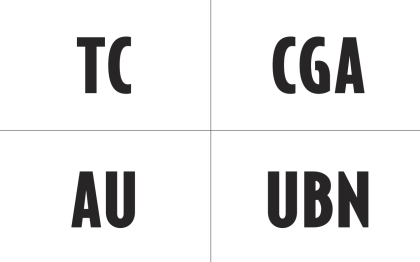
Image: Nonsense Letters – UEN

Image: Fossile Layers – UEN
Objectives:
- Sequence information using items which overlap specific sets
- Relate sequencing to the Law of Superposition
- Show how fossils can be used to give relative dates to rock layers.
Materials:
- Fossils, Rocks, and the Law of Superposition Google Slides – this will walk you through the lesson step-by-step
- Set of 8 cards for each groups – download from the UEN
- additional lesson plan details on their site
- print and cut apart the 8 cards for each part of the lesson
- to set up the cards, use large 4×6 index cards and store in ziptop bags.
- on one side of the index cards, glue on the nonsense letters
- on the reverse side, glue on the fossil layers
- laminate for durability
- Replace the letters for each fossil layer, see my ppt for new random letters
- spelling out the word “ORGANISM“ is way too easy for students to figure out and they will not really have a chance to work on the activity with the depth of thinking and problem solving that you want them to do
- be sure to stagger cards so that the order of the cards is not the same, otherwise they will flip over the cards and have the answer for part 2
- Notes Handout – Law of Superposition Notes (pdf) students will take notes and record their answers on this handout.
Tips for this lesson:
This is a fantastic lesson and I have used it successfully with both 5th and 6th grade students. When introducing this lesson I use the analogy of a laundry hamper, or in most cases, the pile of dirty clothes on the floor in their bedroom. Today’s clothes would go on top of the pile, each day adding a layer of dirty clothes. The older clothes would be on the bottom of the pile, kind of like a timeline of what they wore this week. When that laundry is collected and moved to the laundry room, the layers would get disrupted. With rocks, the layers form on top of each other, and the older layers are on the bottom. We then brainstorm how those layers can be disrupted: earthquakes, tectonic plates moving, landslides, digging, etc…
For this activity, they have to figure out the pattern of how these layers are formed, and there are clues in each layer, they just need to know what to look for. For the nonsense letters, there is a pattern that connects all the layers together. Many will think it is alphabetical, but I tell them that it is not. Once they have worked on it a few minutes, I have them share their theories. Once each group has shared their theory, I give them the clue. And suddenly, the pattern is clear now that they know what to look for. Using the same strategy, they will then sequence the fossils on the reverse side of the index cards.





















